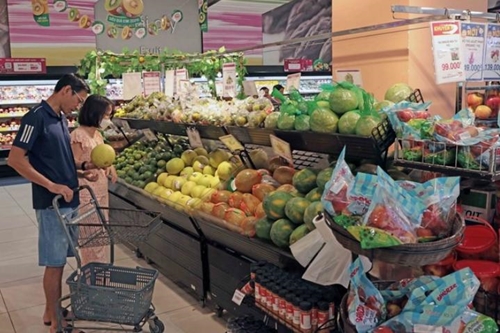Speaking at a press conference in Hanoi, Huong said alongside seasonal factors, adjustments in electricity and healthcare fees, and fluctuations in gold and U.S. dollar prices exerted a clear impact on household expenses.
    |
 |
|
People shop at a supermarket in Hanoi. |
The CPI in June rose by 0.48% compared to the previous month, with urban areas up 0.5% and rural areas up 0.45%. The country’s June CPI climbed 3.57% year-on-year.
In the second quarter, among the 11 main commodity groups, prices rose in 10 groups while only postal and telecommunications services declined.
Consumption demand during the Reunification Day and May Day holidays (April 30 - May 1), as well as the Tet Doan Ngo festival, drove food and catering services prices up 3.69%, contributing 1.24 percentage points to the overall CPI increase. Pork prices alone surged 12.75% due to limited supply, adding 0.43 percentage points to CPI.
Housing, electricity, water, fuels and construction materials rose 5.73%, with higher household electricity tariffs and building material costs adding 1.08 percentage points. Notably, healthcare and medicine prices soared 13.87%, lifting CPI by 0.75 percentage points following adjustments to service price frameworks.
In contrast, fuel prices plummeted by 12.56% in line with global trends, driving transportation costs down 3.63% and subtracting 0.35 percentage points from CPI. Postal and telecommunications prices edged down slightly due to falling prices for older generation mobile phones.
By the end of June, global gold prices averaged 3,369.73 USD per ounce, up nearly 2% from the previous month due to geopolitical instability and safe-haven demand. Domestically, however, gold prices declined 1.27% as authorities adjusted market management policies to reduce monopoly practices.
Meanwhile, the U.S. dollar index dropped 1.34% globally amid expectations of Federal Reserve rate cuts, but domestic USD prices rose 0.32%, reflecting demand for foreign currency to settle export–import transactions.
Core inflation for the first half of 2025 rose by 3.16% year-on-year, slightly below the headline CPI increase of 3.27%. The difference was attributed to notable price hikes in food, electricity and healthcare services, categories excluded from the core inflation calculation.
The National Statistics Office assessed that the Government and relevant ministries had proactively implemented comprehensive measures to keep inflation in check: reducing VAT and environmental protection tax on fuels, lowering lending rates, accelerating public investment disbursement, and ensuring smooth goods circulation.
These efforts contributed to macroeconomic stability, although inflationary pressures remain substantial in the second half of the year as electricity tariffs, service prices and consumption demand continue to rise.
Source: VNA